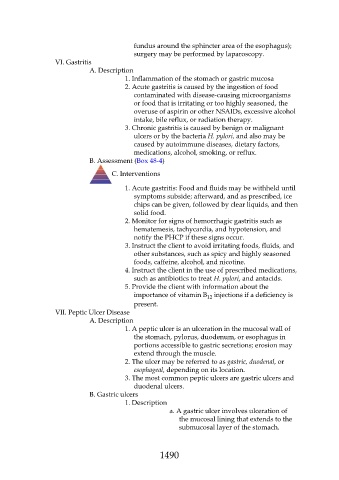Page 1490 - Saunders Comprehensive Review For NCLEX-RN
P. 1490
fundus around the sphincter area of the esophagus);
surgery may be performed by laparoscopy.
VI. Gastritis
A. Description
1. Inflammation of the stomach or gastric mucosa
2. Acute gastritis is caused by the ingestion of food
contaminated with disease-causing microorganisms
or food that is irritating or too highly seasoned, the
overuse of aspirin or other NSAIDs, excessive alcohol
intake, bile reflux, or radiation therapy.
3. Chronic gastritis is caused by benign or malignant
ulcers or by the bacteria H. pylori, and also may be
caused by autoimmune diseases, dietary factors,
medications, alcohol, smoking, or reflux.
B. Assessment (Box 48-4)
C. Interventions
1. Acute gastritis: Food and fluids may be withheld until
symptoms subside; afterward, and as prescribed, ice
chips can be given, followed by clear liquids, and then
solid food.
2. Monitor for signs of hemorrhagic gastritis such as
hematemesis, tachycardia, and hypotension, and
notify the PHCP if these signs occur.
3. Instruct the client to avoid irritating foods, fluids, and
other substances, such as spicy and highly seasoned
foods, caffeine, alcohol, and nicotine.
4. Instruct the client in the use of prescribed medications,
such as antibiotics to treat H. pylori, and antacids.
5. Provide the client with information about the
importance of vitamin B injections if a deficiency is
12
present.
VII. Peptic Ulcer Disease
A. Description
1. A peptic ulcer is an ulceration in the mucosal wall of
the stomach, pylorus, duodenum, or esophagus in
portions accessible to gastric secretions; erosion may
extend through the muscle.
2. The ulcer may be referred to as gastric, duodenal, or
esophageal, depending on its location.
3. The most common peptic ulcers are gastric ulcers and
duodenal ulcers.
B. Gastric ulcers
1. Description
a. A gastric ulcer involves ulceration of
the mucosal lining that extends to the
submucosal layer of the stomach.
1490

